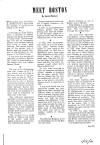| Home Page
Meet Boston Menu
Index
The bridge over the Public Garden Pond is said to be the smallest suspension bridge in the world. * In the days of "King Philip's War," a network of beacon signals was set up as warning of Indian raids. Bonfire material was set on convenient hilltops, and the fires, flashing from town to town, gave warning, The central bonfire pile of this system was in Boston, near the present location of the Bowdoin St. entrance of the State House. It was from this that the hill acquired its name of Beacon Hill, while the road leading to the beacon pile was named Beacon Street. * The part of the Cambridge river front where the M. I. T. now stands, was not filled in till about the turn of the century, and, as late as 1912, it was still broad marsh. Only Massachusetts Avenue crossed the marshes, and over that one road led a volume of traffic between Boston and Cambridge, which was spared the view of the marshes by a long road of billboards on each side of the road. One billboard, apparently erected by a real-estate owner of those parts, attracted considerable attention for the ten years or so that it was standing. It was a pink billboard, reading: "Voici le centre du monde. $100 reward for proof to the contrary." The translation of the French is: "Here is the center of the world." And there seems to be no record of anyone claiming the reward. * Streamlined automobiles are not a recent invention―at least in Boston. In 1911, an auto advertising thermos bottles was seen driving over Harvard Bridge. It was the exact shape of a thermos bottle, with the driver riding the neck of the bottle. * In 1893, when the proposition came up to build a subway under Tremont Street (partly to give work to the unemployed, for 1893 was a depression year), there were many objections to this totally untried idea of cellars for street cars. One was that the air was likely to become stagnant, and that the heavy impurities would collect down there underground. So they were required to install an extensive ventilation system, capable of changing the air every quarter hour. And so, Boston has the only air-conditioned subway system in the world―air conditioning was put in operation in 1897. It was soon found that this ventilation system not only kept the air fresh, and kept the subway warm in winter and cool in summer (contrast New York's hot and stuffy Interborough), but kept the place cleaner than expected. It appears that work was, as a result, done to build the type of electric fan used there into some kind of dust-remover. The result was one of the earliest models of vacuum cleaners. * The Harvard Stadium is not in Cambridge, but in the Boston city limits. Boston College is not in Boston, but in Newton. Tufts College is in two cities (Somerville and Medford) at once. The city line runs through the college yard. * The "snow train" idea started in Boston. It was originally a device of the Boston & Maine Railroad to boost business, after much of the railroad system had been wrecked in the 1927 floods. So, in the winter of 1928, after North Station had been rebuilt, one train was run out of North Station each Sunday as an excursion to some winter sports center. In the following winters, arrangements were made with the New Haven Railroad to run similar excursions from points in Southern New England; and, in 1931, the service was extended to New York City. Since then it has become almost a national institution; but it started in Boston. * The stone building atop Prospect Hill in Somerville is said to have been once, in colonial days, a flour mill. The miller once caught his daughter eloping with a young man he disapproved of, and was unable to prevent them from getting away; so he took out his temper in profanity. The story goes that sometimes, at night, the miller's spirit revisits the scene, and is still swearing so hard that blue flashes are seen coming out of the building. In 1775, the rebel forces, pushed back from Bunker Hill, fortified this building, which remained the rebel outpost till the British were driven out of Boston. It was on this fort that a 13-striped flag first flew.
|
